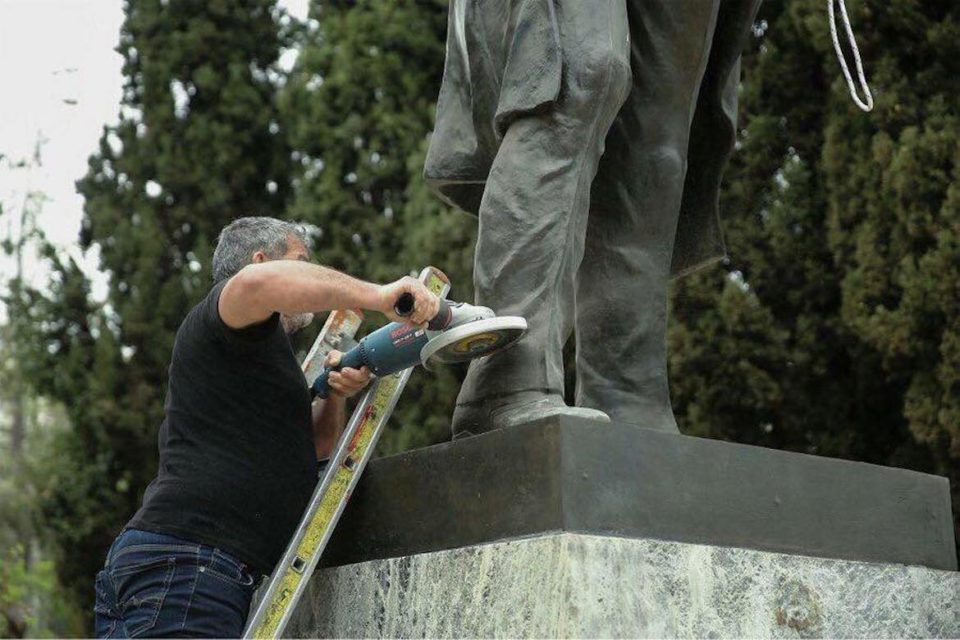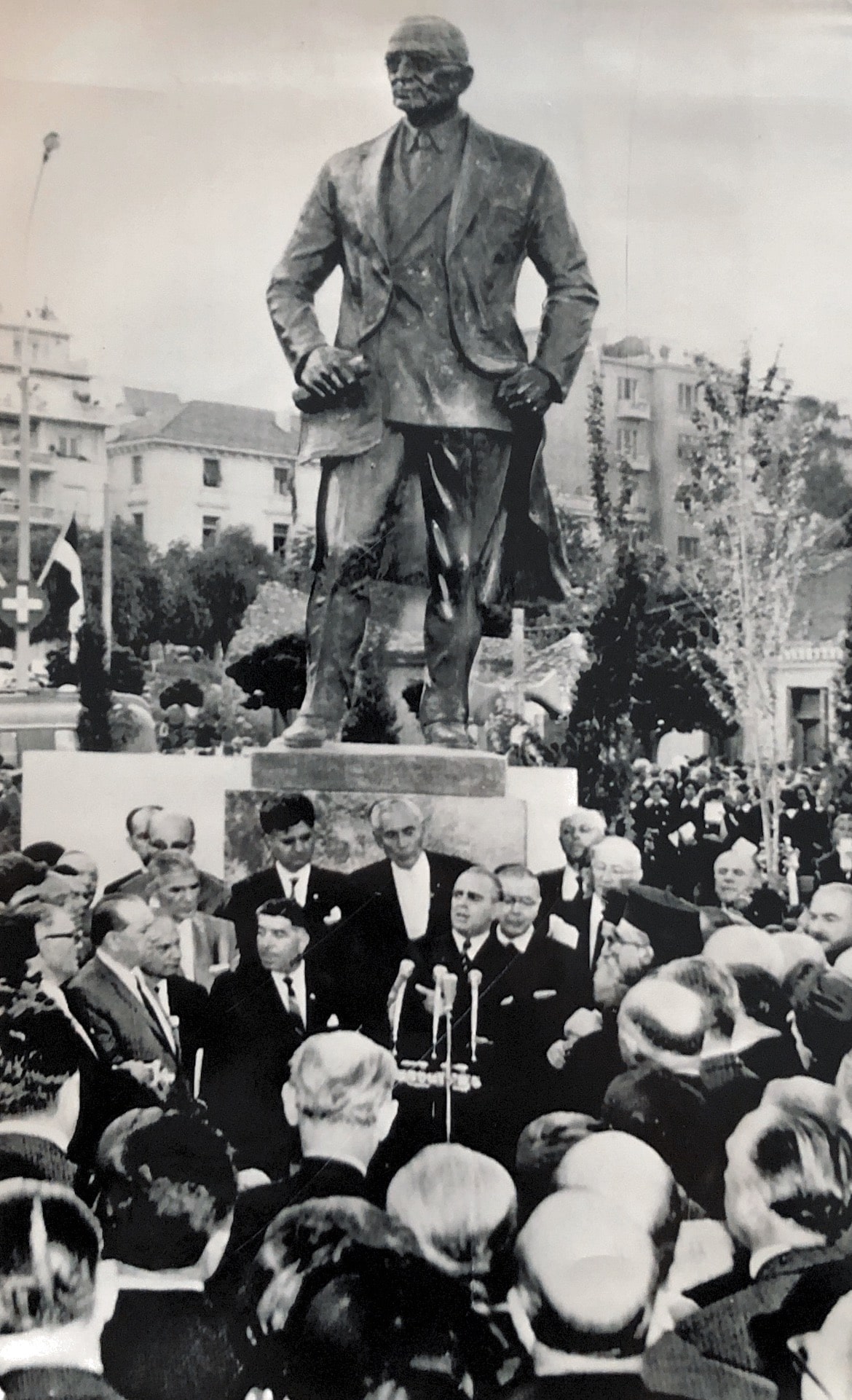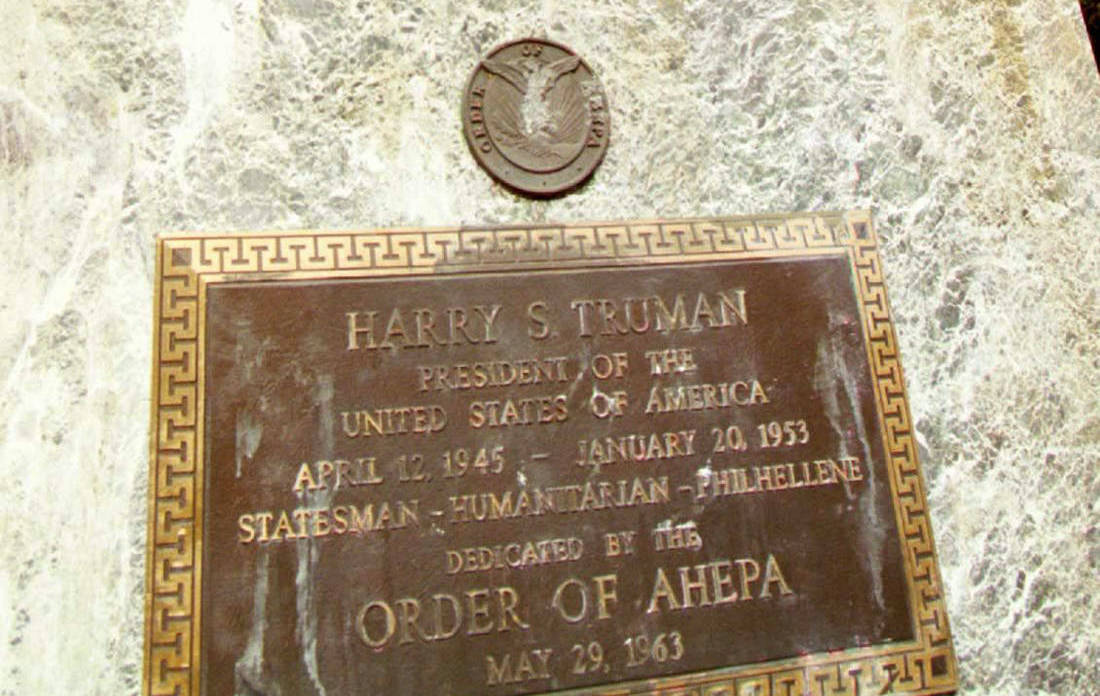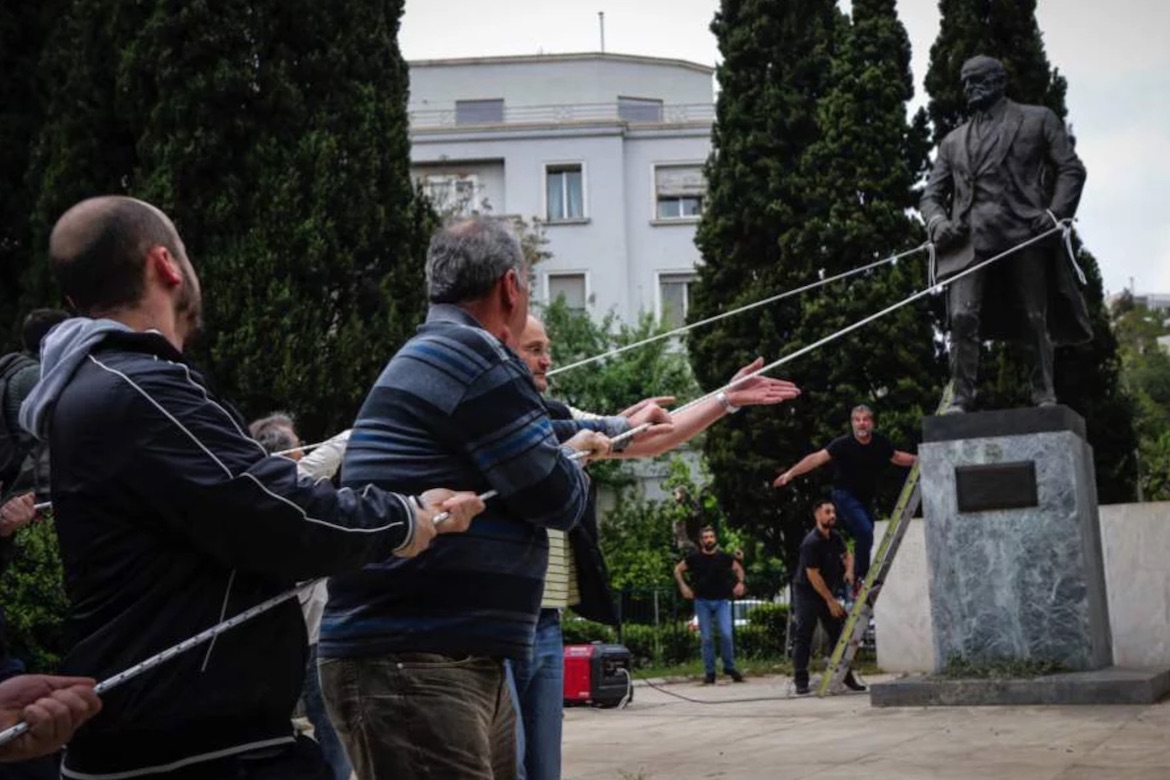Late English poet Alexander Pope once wrote that “Monuments, like men, submit to fate.” For one monument of 33rd U.S. President Harry Truman, apparently that fate includes being uprooted, bombed, painted — and everything in between.
During its more than 50-year history, the Truman statue in central Athens has seen numerous incidents of vandalism from locals voicing anti-American sentiment with origins older than the statue itself.
The most recent episode took place in April 2018, when communist-affiliated union PAME tried removing the statue during a protest against American, British and French airstrikes in Syria. Protesters used a metal grinder to try to cut off the statue’s feet and tug it down with ropes. But riot police intervened and dispersed the crowd.

(Photo / Argiris Makris, INTIME News)
Perhaps the most memorable episode took place in March 1986, when a leftist group protesting what it called “American imperialism” in Greece bombed the monument.
In a follow-up on January 15, 1987, The New York Times published the article “Athens Said to Agree to Put Truman Statue Back.” The Times called the matter a “deeply symbolic issue” while recounting what took place nearly one year before when protestors attacked it.
“The monument was blown off its pedestal a few nights before the arrival of [U.S.] Secretary of State George P. Shultz, in protest against any improvement in [Greek-American] relations,” the article read. “Responsibility for the action was claimed by a group calling itself the Christos Cassimis Revolutionary Organization, named for a militant killed in 1978 in a gunfight with the police.”
After an initial “no” vote by the Athens City Council in April 1986, Socialist Greek Prime Minister Andreas Papandreou did agree to re-erect the Harry Truman statue. The move came as a surprise to Papandreou’s supporters, as he had previously won elections on the promise to significantly cut Greece’s ties with the U.S., and to leave the North Atlantic Treaty Organization (NATO) and the European Community (EEC).
But more than a year and a half would pass by the time that officials restored it in its original place near the National Garden. On August 7, 1987, the statue was replaced in the middle of the night under heavy security. That day, the NY Times reported:
“The pro-Moscow Greek Communist Party today charged that the restoration of the statue ‘conflicts with the anti-American sentiments of the Greek people.’ It said it was a ‘humiliating act’ that demonstrated the government’s attempt to gain favor with the United States leading up to talks on the renewal of an agreement on American military bases here.”

Other incidents involving the Truman statue include two bombings during the years of Greece’s military dictatorship from 1967 and 1974. One of the bombings in 1971 killed an on-duty policeman.
In May 1999, vandals sawed the feet of the statue and forced it to collapse from its pedestal.
In 2003, members of left-wing organizations covered the statue with wrapping paper as if to pack it for shipping and wrote “return to sender.”

On July 25, 2006, members of PAME tied the statue with ropes and brought it down yet again from its pedestal.

And in May 2013, unknown vandals splattered Truman’s likeness with red and pink paint, adding to the list of ways in which the statue had been “bullied.”

Why the controversy?
It isn’t so much about Harry Truman himself as it is what the statue symbolizes to the protesting Greeks.
After World War II, an already war-ravaged Greece entered into a civil war between U.S.-backed government forces and pro-USSR communists. Through the Truman Doctrine and Marshall Plan, the Americans provided political, military and economic assistance to Greece, among other recovering European nations.
Truman’s particular interest in Greece resulted from the country’s strategic position — both literally and figuratively — in America’s new Cold War against the Soviet Union. Greece’s neighboring countries such as Yugoslavia, Albania and Bulgaria had already fallen under the Easter European Soviet umbrella. And Truman aimed to prevent Greece from the same fate.
The U.S. government provided Greece not only with Marshall Plan aid, but also with military advisors and equipment for the national army. This prompted a series of successful government offensives, and in August 1949 Greek forces wiped out the final communist stronghold at Grammos near the Albanian border.
An immediate effect of Greece’s civil war were the estimated 158,000 deaths that it caused. But the longer-lasting effect — and one which persists today — is the anti-American sentiment among Greece’s communist factions.
For left-wing factions, the American aid received during the civil war was “blood money” exclusively intended to support pro-government areas and neglect pro-communist regions.
Greece’s political left also widely blames the U.S. for facilitating the coup which enabled the Greek military junta to take control from 1967 to 1974. Truman had finished his final term as president more than a decade prior, but for Greek protestors his statue nonetheless represents the same “imperialistic” country.
In 2018, Greek public broadcaster EPT3 produced a segment titled “Harry Truman: The Statue and the History.” The segment discusses the interconnectivity of the Truman Doctrine, Greek civil war, Cold War and tensions between Greek communists and imperialists.
Origins of the Harry Truman statue
AHEPA gifted the Truman statue on behalf of Greek Americans when it was dedicated on May 29, 1963, before an audience of 20,000.
In his message that was read to the crowd, U.S. President John F. Kennedy stated: “I hope this outstanding memorial, which the Order of AHEPA has made possible, will come to symbolize not only our common heritage and efforts, but will serve to remind us of the high priority President Truman gave the progress of Greece toward economic development and social justice in peace and freedom.”
Greek Prime Minister Constantine Caramanlis stated what he believed to be the importance of the Truman Doctrine at the statue’s unveiling ceremony.
“If the Greeks want to survive as a free nation, they should not forget the dramatic period with which Mr. Truman’s name is linked,” Caramanlis said. “Should they forget it, they would deserve their fate and have no right to ask for anyone’s help.”

(Photo from the personal collection of Gregory C. Pappas)
Harry Truman was a member of AHEPA, joining on March 25, 1946 during ceremonies held at the White House. He was a member of AHEPA Chapter 73 in Kansas City, Missouri.
On the front side of Truman’s statue and below his feet, a bronze plaque bears his name as well as the date of the statue’s inauguration by AHEPA.

Is The Pappas Post worth $5 a month for all of the content you read? On any given month, we publish dozens of articles that educate, inform, entertain, inspire and enrich thousands who read The Pappas Post. I’m asking those who frequent the site to chip in and help keep the quality of our content high — and free. Click here and start your monthly or annual support today. If you choose to pay (a) $5/month or more or (b) $50/year or more then you will be able to browse our site completely ad-free!

Click here if you would like to subscribe to The Pappas Post Weekly News Update
